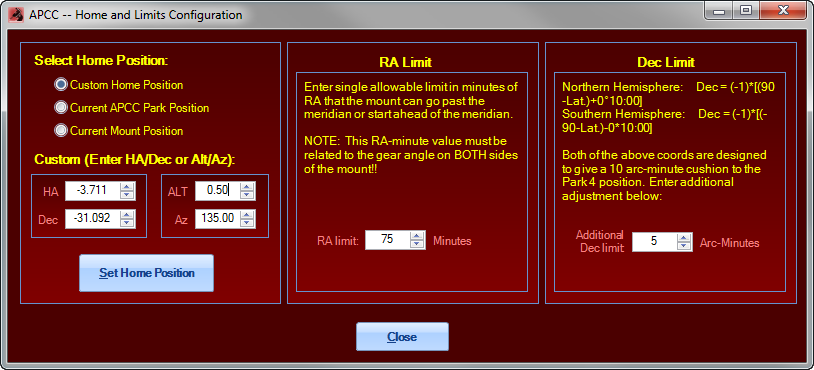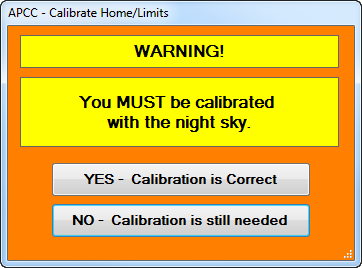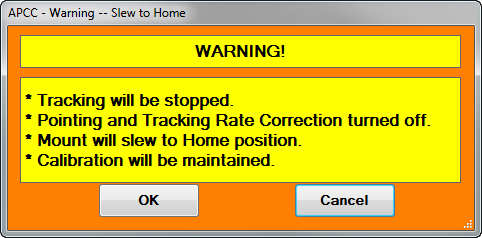Configure Home and Limits
Introduction

The Configuration Window is where you will set the position you wish to call "Home." It is also where you can set parameters for your limits in both RA and Dec.
•It is a good idea to think about this before you actually make the configurations, although you can always redo them. You will want to decide on the position you wish to use for "Home." Do you want "Home" to point to a flat-field light-box? Do you have roof closure issues? Do you prefer to have "Home" point at the zenith, or the pole, or maybe a distant light on a radio tower? Or maybe you prefer to have "Home" be equivalent to an AP Park Position that you already use.
•Know ahead of time how far past the meridian you want to set your RA Limit. Since limits are easily enabled and disabled from the Homing/Limits Tab, you will probably want to set this as a "worst case" limit. Remember also that a 1200X slew is moving the mount at 5 degrees per second. The system needs time to react and decelerate to stop if you slew into the limit. These are, after all, software limits. They are not physical barriers.
•One doesn't usually think of the need for a Dec Limit in a German Equatorial mount, but there is a zone at the rear of the mount, basically on either side of the opposite pole, where a properly operating Dec axis will simply never go. The size of this zone is determined by your latitude. In a nutshell, if your Dec axis crosses into this zone, then something is wrong, and corrective action needs to be taken.
When you first click on the Configure Home and Limits button at the top right of the Home/Limits Tab in APCC, you will be given the following warning:

You must be calibrated with the sky before you configure your Home position. The more accurate the calibration, the more accurate any homing recovery operation will be. For the greatest accuracy, you can do a plate-solve and ReCal on an object that is on the same side of the meridian as your chosen home position, and is also high enough in the sky to avoid too much refraction. Also, avoid doing your ReCal at a high declination (low declination in the southern hemisphere) where RA lines are compressed and lose resolution. A good practice is to choose a target on the same side of the meridian as "Home" that is between the zenith and the celestial equator ( 0 Dec).
Select Home Position Box
The Select Home Position box is where you set where "Home" will be. There are three approaches that can be taken to selecting your home position.
1.Use your own custom Home position. If you select this option you will need to enter either an Hour Angle (HA) / Dec set of coordinates, or else an Alt / Az set. This is done in the boxes below the three radio selection buttons. The example above might be for a dome with a flat-field light-box located southeast of the pier.
2.Use the Current APCC Park Position. This automatically enters the coordinates for the park position you have selected in the Park Tab. You can then select Park to the Home position in the Park Tab, and all future parks will use the homing function rather than the normal park sequence. This might be especially advantageous for remote observers in that it will correct any errors that might have happened during the night's remote session. If you have chosen Park 4, for example so that your roof will close, the mount will park precisely to Park 4 even if something got the mount a bit lost while you were asleep.
3.Select the current mount position. This might be the easiest way to precisely aim the mount at a flat-field box, a laser safety switch, or a distant known terrestrial target unless you already know the exact coordinates. Simply toggle the tracking to STOP, move the mount into the exact position you want, and then proceed to set the Home position.
Once you decide on, and select your Home position, click the Set Home Position button. The following warning will appear:

If you selected #1 or 2 above, clicking OK will slew the mount to the chosen home position for verification. If you chose #3, you are already there, and no slew will take place. Once at your "Home" position, APCC will configure the position in the GTO Servo Control Box. When finished, the following will appear to indicate success.

You now have a configured Home position that will remain valid until the mount is moved via the clutches.
RA Limit Box
The RA Limit Box allows you to set how far past the meridian you want to allow your mount to travel. Only a single value is allowed. It is therefore best to consider a worst-case scenario on both sides of the mount. Set the RA Limit that you would want for UNMONITORED operation of the mount. If you will be sitting at the computer during the night's session, you can easily uncheck the RA Limits on the main Homing/Limits Tab if you wish to take advantage of the Meridian Limits you have set on the Meridian Tab.
Your limits are set in RA minutes. (Each RA minute = 15 arc-minutes. 4 RA minutes = 1 degree.) When deciding on the limit value, bear in mind that you need a safety cushion to accommodate a potential errant slew in progress. Tracking presents no problem, but when slewing at 1200X, the mount is moving at 5 degrees per second. The gear angles are polled by APCC once per second. In addition, the mount will need a small amount of time to decelerate to a stop. If you could hit the pier at 1h 40m past the meridian, you might want to set the limit at 1h 10m or 70 RA minutes to provide the safety margin. You can decrease the safety margin and thereby increase the distance past the meridian by using a slower slew speed like 600X.
You can either type in the number of RA minutes you wish to set or use the up/down arrows on the entry box to arrive at the desired value.
Dec Limit Box
The very idea of declination limits may seem counter-intuitive. After all, the Dec. must slew all over on both sides of the pole. However, in a properly operating German Equatorial mount, there is a zone around the opposite pole from your hemisphere where the axis should never go. The size of this zone is dependent upon your latitude, and the absolute value is calculated for you by APCC.
Violation of this zone is not a sure sign of imminent disaster as it may be in right ascension. However, it is a sure sign that something is wrong and that you have done something to get the mount lost. We recommend that the Dec. Limit always be activated. The only valid reason we can think of for disabling the Dec limit is if you have moved the mount via the clutches, and have not yet reestablished home and limits.
The calculated value provides a 10 minute safety margin so that Park 4 will not accidentally trigger the limit. If you use Park 4, you may add an additional cushion if you wish, but it is only rarely needed, and we suggest keeping any additional limit to a minimum.
You can either type in the number of arc-minutes you wish to add to the provided cushion or use the up/down arrows on the entry box to arrive at the desired value.
